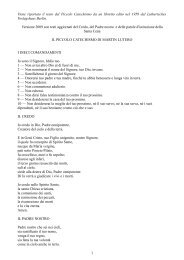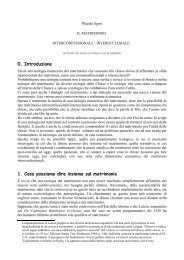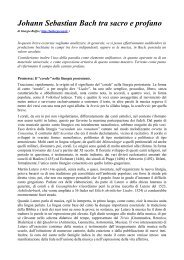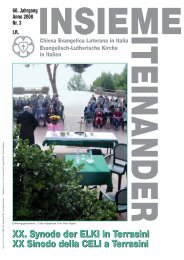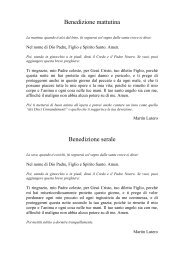Il dialogo ecumenico e interreligioso: quale futuro? - Nemesistemi
Il dialogo ecumenico e interreligioso: quale futuro? - Nemesistemi
Il dialogo ecumenico e interreligioso: quale futuro? - Nemesistemi
You also want an ePaper? Increase the reach of your titles
YUMPU automatically turns print PDFs into web optimized ePapers that Google loves.
comunicazione 1 . Nella comunicazione dai linguaggi si incontrano tutte le dimensioni<br />
dell'esperienza umana 2 . La problematica comunicativa si apre -dunque- alle esigenze fondamentali<br />
del '<strong>dialogo</strong>', superando il concetto della 'trasmissione strumentale' in quanto veicolo 'neutrale' di<br />
discorsi già pronti. <strong>Il</strong> <strong>dialogo</strong> comunicativo sorge dal coinvolgimento di tutti, degli utenti in<br />
particolare 3 . Occorrerà riesaminare la presenza ecclesiale nella comunicazione partendo dalle<br />
urgenze del '<strong>dialogo</strong>' a tutti i livelli, tra cattolici, tra cristiani, con le altre religioni dell'umanità, con<br />
la comunità umana stessa. Si suggeriva nella linea della Gaudium et spes- che il fenomeno<br />
comunicativo alla pari di tutte le realtà create aveva una sua specificità propria 4 . Uno degli ultimi<br />
documenti della Conferenza episcopale degli Stati Uniti comincia a parlare esplicitamente di<br />
"information society" 5 . <strong>Il</strong> tipo di presenza ecclesiale che si auspica in tale contesto è quello del<br />
'<strong>dialogo</strong> pubblico' 6 . Esso costituisce il criterio fondamentale della comunicazione da parte della<br />
Chiesa 7 . <strong>Il</strong> <strong>dialogo</strong> si trova alla base delle priorità umane in quanto tali. <strong>Il</strong> <strong>dialogo</strong> pubblico sorge<br />
da questo <strong>dialogo</strong> fondamentale che costituisce la specificità dell evento umano e nel <strong>quale</strong> si<br />
iscrive l intento ecclesiale stesso. L'accenno ci pare importantissimo: a differenza della premessa<br />
anteriore secondo la <strong>quale</strong> le scelte religiose ed ecclesiali entravano a far parte della "sfera privata"<br />
e non pubblica della vita sociale, adesso si prende atto che la comunicazione stessa inserisce le<br />
del nostro faticoso comunicare interpersonale, ecclesiale`, sociale. Possiamo anche individuare le tre parti di questa Lettera: 1. rendersi conto delle<br />
proprie difficoltà comunicative; 2.lasciarsi toccare e risanare da Gesù; 3. riaprire i canali della comunicazione a tutti i livelli .<br />
1 W.A. Vissert' Hooft, Hat die Ökumenische Bewegung Zukunft?, in «Ökumenische Rundschau», 1975 nº 2, p. 164..<br />
2 L. Leonardi, La riflessione ermeneutica in prospettiva ecumenica, in «Quaderni di o odigos», 1992 nº 3, p.15.<br />
3 COMMISSION PONTIFICALE DES COMMUNICATIONS SOCIALES, Instruction pastorale Communio et progressio , Cité du Vatican 1971,<br />
n<br />
81: Les possibilités des récepteurs<br />
sont plus larges et, par conséquent, leurs responsabilités sont plus importantes qu'on ne le croit<br />
communément. La poursuite d'un véritable dialogue dépend, en grande partie, des usagers. S'ils demeurent passifs devant les moyens de la<br />
communication, celle-ci restera à sens unique, malgré les efforts des professionnels pour établir le dialogue .<br />
4<br />
COMMISSION PONTIFICALE POUR LES COMMUNICATIONS SOCIALES, Instruction pastorale Communion et progrès , Cité du Vatican<br />
1971, nº 14 : «Puisque c'est l'homme lui-même qui décide de la manière d'utiliser les inventions, les principes moraux qui les régissent reposent sur la<br />
juste considération de la dignité de l'être humain, appelé à participer à la société des fils adoptifs de Dieu. D'autre part, ces principes découlent aussi<br />
de la nature intime de la communication sociale et des qualités propres à chacun de ses moyens. Cela ressort également de la Constitution pastorale<br />
«Gaudium et Spes»: C'est en vertu de la création même que toutes choses sont établies selon leur consistance, leur vérité et leur excellence propres,<br />
avec leur ordonnance et leurs lois spécifiques, que l'homme doit respecter ... » (n. 36)».<br />
5<br />
UNITED STATES CATHOLIC CONFERENCE, In the Sight of All, Washington 1986, pp. 8-9: 8. The Catholic Church in the United States is<br />
affected by communication in other ways, too. First, the church is an object of other people's communication. The witness of Christian living kads<br />
peopie to proebim God's goodness. 1 Journalists write about the church; television networks cover papal travels; films, plays, novels, and television<br />
drama find in the church fascinating subject matter. Whether in news or entertainment, the church in its institutions, offcials, and individuals is part of<br />
the information sockty of the United States. Second, church members form an aiudience that is a religious audience, hearing, reading and sharing the<br />
message of the Lord. At the same time, however, we form an audience for other messages messages about power, about consumption, about many<br />
values we do not hold .<br />
( 1 Lumen Gentium, #38. in Vatican Council II, the Conciliar and Post Conciliar Documents, ed Austin Flannery (Collegeville MN: Liturgical Press,<br />
1975), p. 569.)<br />
6<br />
UNITED STATES CATHOLIC CONFERENCE, In the Sight of All, Washington 1986, pp. 8-9: A PUBLIC DIALOGUE OF FAITH AS THE<br />
GENERAL PRINCIPLE OF CHURCH COMMUNICATION. 9. Thus, the Catholic Church in the United Sates is in public dialogue with American<br />
society. From the perspective of communication, the church represents a public dialogue of faith. First, the church is public. We proclaim the Gospel<br />
and build up our community openly "in the sight of all.<br />
Because no one can be exeluded, the church publicly manifests Christ's presence in the<br />
world. Communication implies this public quality: to communiate is to share, to overcome isolation and individuality, and to become community.<br />
Second, the nature of our community and its place within American society lead to dialogue. For true communication, people must listen as well as<br />
speak; in this way, communication leads to communion. The Second Vatican Council committed the church in the contemporary world to dialogue<br />
that leads to "a feeling of deep solidarity with the human race and its history." 1 As American bishops, we also recognize that genuine communication<br />
must allow a11 men and women a voicc in the dialogue. Third, the church is a community of faith whose communication always engages that faith.<br />
Our dialogue is rooted in faith; its subject ultimately is the Lord. Through our prayer and our teaching, as pastors of the Catholic Church in the<br />
United States, we gather the community Of disciples. This faith reaches its fullness not in doctrine alone, but in acts of charity, justicc, and peace. 2<br />
Communiation, too, reaches its fullness in mutual love. 3 Thus we share a common vision of communication in Jesus Christ, the living Word, the<br />
perfect communiator, the Teacher and Listener who unites us in his Body and in the Kingdom of God 4 .<br />
( 1 Lumen Gentium, #1 see also #3. in Vatican Council II, the Conciliar and Post Conciliar Documents, ed Austin Flannery (Collegeville MN:<br />
Liturgical Press, 1975), pp. 903-904. And so the Council, as witness and guide to the faith of the whole people of God, gathered together hy Christ,<br />
can find no more eloquent expression of its solidarity and respectful affection for the whole human family, to which it belongs, than to enter into<br />
dialogue with it . / 2 James 2: 14-26. / 3 I John 4. / 4 A vision All can share, "Mission Statement," p. 8. A Vision All can share Conference Mission<br />
Statement," in William Thorn, ed. A Vision All can Share Report on the Conference at Marqette University, June 11-13 1984 (Washington D.C.<br />
United States Catholic Conference, 1985), p. 8.)<br />
7 UNITED STATES CATHOLIC CONFERENCE, In the Sight of All, Washington 1986, p. 11: 14. This same right and need of all people for true<br />
dialogue lies at the heart of communication policy as well. Effective communication demands a knowledge and love that comes only from dialogue.<br />
Because the church desires to enter into communication with church members and non-members alike, the style of our communication must reRect<br />
the loving, communicative nature of the church. We must learn the needs, concerns, symbols, and language of the people, as well as the media in<br />
which they are literate. To this end, we endorse communication research on behalf of the church and urge that our bishops, in their dioceses and<br />
through the USCC Department of Communication, foster national coòp eration for communication research, planning, and strategy. 1 .<br />
( 1 A Vision All Can Share, "Recommendations," II. A. 2. p. 11. In addition, we commend the Catholic Press Association for commissioning the<br />
Annenberg/Gallup study of the Catholic press. and the Catholic Communication Campaign for commissioniny the Annenoerg study of Religion and<br />
Television.)<br />
28



